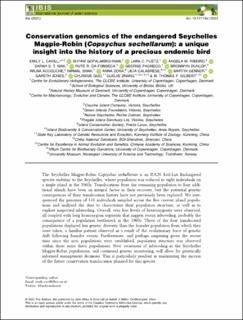Conservation genomics of the endangered Seychelles Magpie-Robin (Copsychus sechellarum): a unique insight into the history of a precious endemic bird
| dc.contributor.author | Cavill, Emily L. | |
| dc.contributor.author | Gopalakrishnan, Shyam | |
| dc.contributor.author | Puetz, Lara C. | |
| dc.contributor.author | Ribeiro, Ângela M. | |
| dc.contributor.author | Mak, Sarah S. T. | |
| dc.contributor.author | da Fonseca, Rute R. | |
| dc.contributor.author | Pacheco, George | |
| dc.contributor.author | Dunlop, Bronwyn | |
| dc.contributor.author | Accouche, Wilna | |
| dc.contributor.author | Shah, Nirmal | |
| dc.contributor.author | Zora, Anna | |
| dc.contributor.author | Calabrese, Licia | |
| dc.contributor.author | Genner, Martin | |
| dc.contributor.author | Jones, Gareth | |
| dc.contributor.author | Guo, Chunxue | |
| dc.contributor.author | Zhang, Guojie | |
| dc.contributor.author | Gilbert, Marcus Thomas Pius | |
| dc.date.accessioned | 2022-03-02T10:08:03Z | |
| dc.date.available | 2022-03-02T10:08:03Z | |
| dc.date.created | 2021-11-23T15:05:30Z | |
| dc.date.issued | 2021 | |
| dc.identifier.issn | 0019-1019 | |
| dc.identifier.uri | https://hdl.handle.net/11250/2982377 | |
| dc.description.abstract | The Seychelles Magpie-Robin Copsychus sechellarum is an IUCN Red-List Endangered species endemic to the Seychelles, whose population was reduced to eight individuals on a single island in the 1960s. Translocations from the remaining population to four additional islands have been an integral factor in their recovery, but the potential genetic consequences of their translocation history have not previously been explored. We resequenced the genomes of 141 individuals sampled across the five current island populations and analysed the data to characterize their population structure, as well as to explore suspected inbreeding. Overall, very low levels of heterozygosity were observed, all coupled with long homozygous segments that suggest recent inbreeding, probably the consequence of a population bottleneck in the 1960s. Three of the four translocated populations displayed less genetic diversity than the founder population from which they were taken, a familiar pattern observed as a result of the evolutionary force of genetic drift following founder events. Furthermore, and perhaps surprising given the recent time since the new populations were established, population structure was observed within these same three populations. New awareness of inbreeding in the Seychelles Magpie-Robin populations, and continued genetic monitoring, will allow for genetically informed management decisions. This is particularly prudent in maximizing the success of the future conservation translocation planned for this species. | en_US |
| dc.language.iso | eng | en_US |
| dc.publisher | Wiley | en_US |
| dc.rights | Navngivelse 4.0 Internasjonal | * |
| dc.rights.uri | http://creativecommons.org/licenses/by/4.0/deed.no | * |
| dc.title | Conservation genomics of the endangered Seychelles Magpie-Robin (Copsychus sechellarum): a unique insight into the history of a precious endemic bird | en_US |
| dc.type | Journal article | en_US |
| dc.type | Peer reviewed | en_US |
| dc.description.version | publishedVersion | en_US |
| dc.source.journal | IBIS | en_US |
| dc.identifier.doi | 10.1111/ibi.13023 | |
| dc.identifier.cristin | 1957972 | |
| cristin.ispublished | true | |
| cristin.fulltext | original | |
| cristin.qualitycode | 1 |
Tilhørende fil(er)
Denne innførselen finnes i følgende samling(er)
-
Institutt for naturhistorie [1245]
-
Publikasjoner fra CRIStin - NTNU [38679]

